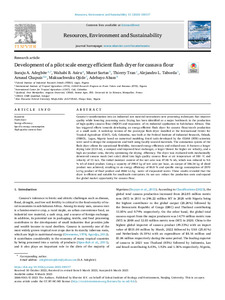| dc.contributor.author | Adegbite, S.A. |
| dc.contributor.author | Asiru, W.B. |
| dc.contributor.author | Sartas, M. |
| dc.contributor.author | Tran, T. |
| dc.contributor.author | Taborda, L.A. |
| dc.contributor.author | Chapuis, A. |
| dc.contributor.author | Ojide, M. |
| dc.contributor.author | Abass, A. |
| dc.date.accessioned | 2023-05-11T08:54:19Z |
| dc.date.available | 2023-05-11T08:54:19Z |
| dc.date.issued | 2023-09 |
| dc.identifier.citation | Adegbite, S.A., Asiru, W.B., Sartas, M., Tran, T., Taborda, A.L., Chapuis, A., ... & Abass, A. (2023). Development of a pilot scale energy efficient flash dryer for cassava flour. Resources, Environment and Sustainability, 13: 100117, 1-8. |
| dc.identifier.issn | 2666-9161 |
| dc.identifier.uri | https://hdl.handle.net/20.500.12478/8168 |
| dc.description.abstract | Cassava’s transformation into an industrial raw material necessitates new processing techniques that improve quality while lowering processing costs. Drying has been identified as a major bottleneck in the production of high-quality cassava flour (HQCF) and expansion of its industrial application in Sub-Sahara African. This has triggered efforts towards developing an energy-efficient flash dryer for cassava flour/starch production at a small scale. A scaled-up version of the prototype flash dryer installed at the International Center for Tropical Agriculture (CIAT), Cali, Colombia, was built at the Federal Institute of Industrial Research, Oshodi, (FIIRO), Lagos, Nigeria based on numerical modeling. Excel tools developed by the CGIAR (RTB) scientists were used to design the components and built using locally sourced materials. The automation system of the flash dryer allows for operational flexibility, increased energy efficiency and reduced cost. It features a longer drying tube (22.5 m), a compact and improved heat exchanger, a larger blower for higher air velocity, and a high air/product ratio, thereby optimizing the drying efficiency. The dryer was evaluated with mechanically dewatered cassava mash (wet cake) dried into high quality cassava flour at air temperature of 180 °C and velocity of 13 m/s. The initial moisture content of the wet cake was 47.06 % wb, which was reduced to 9.6 % wb of dried product. Using a capacity of 298.0 kg of wet cake per hour, an output of 186.34 kg of dried product was achieved, resulting in an energy efficiency of 80.8 % and specific energy consumption of 2570 kJ/kg product of final product and 4560 kJ/kg water of evaporated water. These results revealed that the dryer is efficient and suitable for small-scale enterprises. Its use can reduce the production costs and expand the global market opportunity for cassava flour. |
| dc.description.sponsorship | CGIAR Trust Fund |
| dc.format.extent | 1-8 |
| dc.language.iso | en |
| dc.subject | Dryers |
| dc.subject | Energy Efficiency |
| dc.subject | Energy Consumption |
| dc.subject | Cassava |
| dc.subject | Flours |
| dc.title | Development of a pilot scale energy efficient flash dryer for cassava flour |
| dc.type | Journal Article |
| cg.contributor.crp | Roots, Tubers and Bananas |
| cg.contributor.affiliation | Federal Institute of Industrial Research Oshodi |
| cg.contributor.affiliation | International Institute of Tropical Agriculture |
| cg.contributor.affiliation | International Center for Tropical Agriculture |
| cg.contributor.affiliation | Université de La Réunion |
| cg.contributor.affiliation | Centre de Coopération Internationale en Recherche Agronomique pour le Développement |
| cg.contributor.affiliation | Alex Ekwueme Federal University |
| cg.coverage.region | Africa |
| cg.coverage.region | West Africa |
| cg.coverage.country | Nigeria |
| cg.coverage.hub | Eastern Africa Hub |
| cg.coverage.hub | Central Africa Hub |
| cg.researchtheme | Social Science and Agribusiness |
| cg.identifier.bibtexciteid | ADEGBITE:2023 |
| cg.authorship.types | CGIAR and developing country institute |
| cg.iitasubject | Agribusiness |
| cg.iitasubject | Agronomy |
| cg.iitasubject | Cassava |
| cg.iitasubject | Food Security |
| cg.iitasubject | Plant Production |
| cg.iitasubject | Post-Harvesting Technology |
| cg.journal | Resources, Environment and Sustainability |
| cg.notes | Open Access Article; Published online: 08 Mar 2023 |
| cg.accessibilitystatus | Open Access |
| cg.reviewstatus | Peer Review |
| cg.usagerightslicense | Creative Commons Attribution-NonCommercial-NoDerivatives 4.0 (CC BY-NC-ND 4.0) |
| cg.targetaudience | Scientists |
| cg.identifier.doi | https://doi.org/10.1016/j.resenv.2023.100117 |
| cg.iitaauthor.identifier | Murat Sartas: 0000-0001-7331-4201 |
| cg.iitaauthor.identifier | Adebayo Abass: 0000-0003-1376-3608 |
| cg.futureupdate.required | No |
| cg.identifier.issue | : 100117 |
| cg.identifier.volume | 13 |

